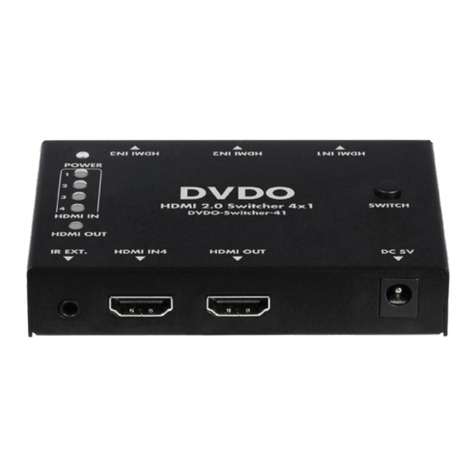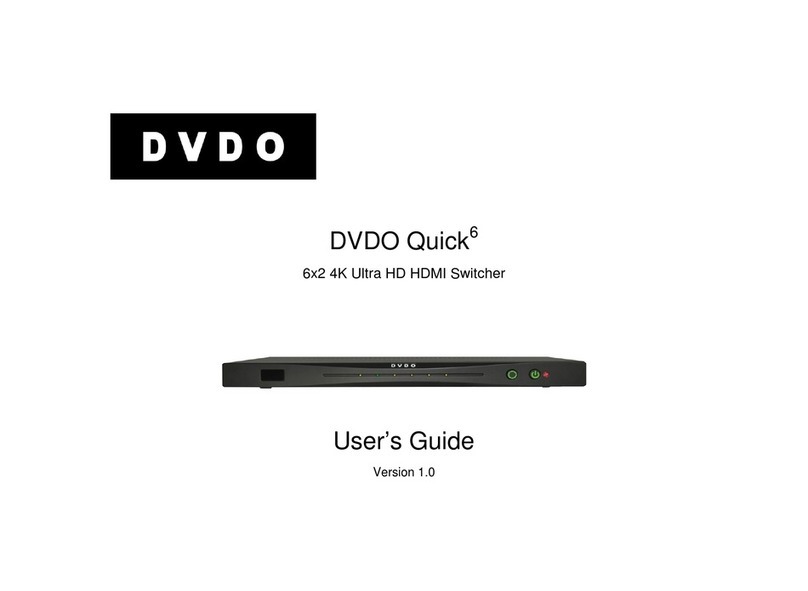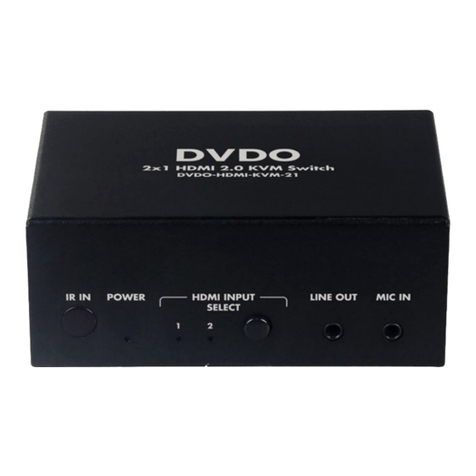DVDO Quick6R 6x2 4K Ultra HD HDMI Switcher
DVDO-UG-1001-B.01 © 2014 Silicon Image, All rights reserved 10
If the Quick6R connection to the AVR is from the AUX HDMI output, then choose AVR via AUX HDMI in the
output setup menu. If the Quick6R connection to the AVR is from the optical or coax S/PDIF output, then
choose AVR via S/PDIF in the output setup menu.
Why Use AVR Mode?
The AVR mode extends the life of your existing AVR. In most installations, the AVR is used not only as the
audio amplifier but also as the central video switch. Since the audio needs to match the video being
displayed, running everything through the AVR is the simplest method. While AVRs tend to have a long life
and continue to provide basic audio functions, video standards and features change more often. Adding
Quick6R to an existing system upgrades the entire entertainment center to the latest features. With Quick6R
installed, the AVR becomes the primary audio processor and Quick6R becomes the primary switch in the
system. Quick6R routes the best possible audio to the AVR and the best possible video to the TV.
Audio and Video Resolution and Routing
When Quick6R is put into AVR via AUX HDMI mode, the full audio capabilities of the AVR are scanned and
combined with the best possible video capabilities of the TV and the combination is reported back to all
inputs. In this way, the inputs send the best possible audio routed to the AVR and the best possible video
routed to the TV. Since the input signal could have a resolution of up to 4K (Ultra HD) with HD audio, and
the TV may not be able to handle HD audio, Quick6R mutes the audio going to the TV when the AVR is on.
HD Audio includes Dolby®TrueHD as well as DTS-HD Master Audio™ formats.
When the AVR is disconnected or powered off, the audio capability of the TV which is normally just PCM
stereo is reported back to the inputs and the TV audio is unmuted. In this way you can choose to watch a
program just with the TV audio (AVR off) or with full surround sound from the AVR (no audio from the TV).
This special negotiation only happens if the AVR is connected to the AUX HDMI output.
When Quick6R is put into AVR via S/PDIF mode, the video capabilities of the TV are scanned and combined
with a prestored capability list of a standard AVR connected through S/PDIF and the combination is reported
to all the inputs. This is necessary because the capabilities of the connected AVR cannot be read through
S/PDIF. This allows full TV resolution up to 4K while delivering the full audio capabilities possible over
S/PDIF, including bit stream such as Dolby, DTS, and other formats. In this mode, Quick6R also mutes the
audio going to the TV to prevent formats unknown to the TV from causing unwanted noise.































